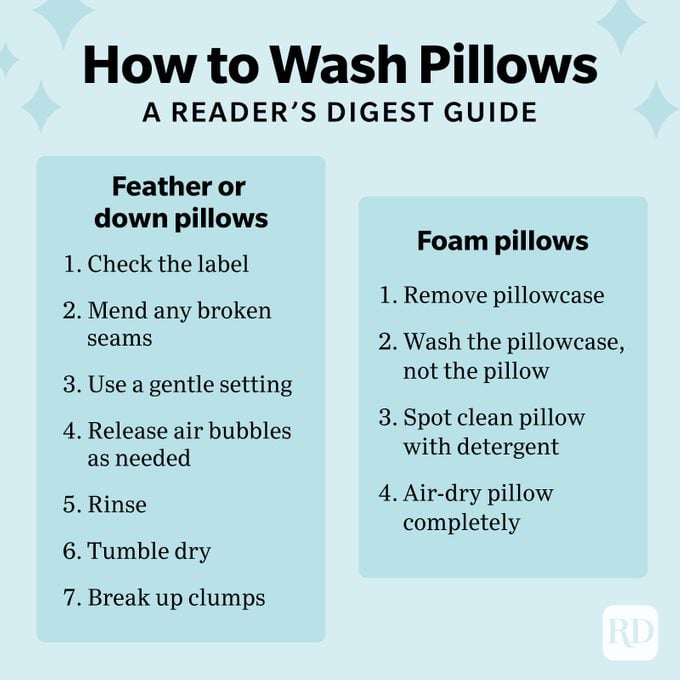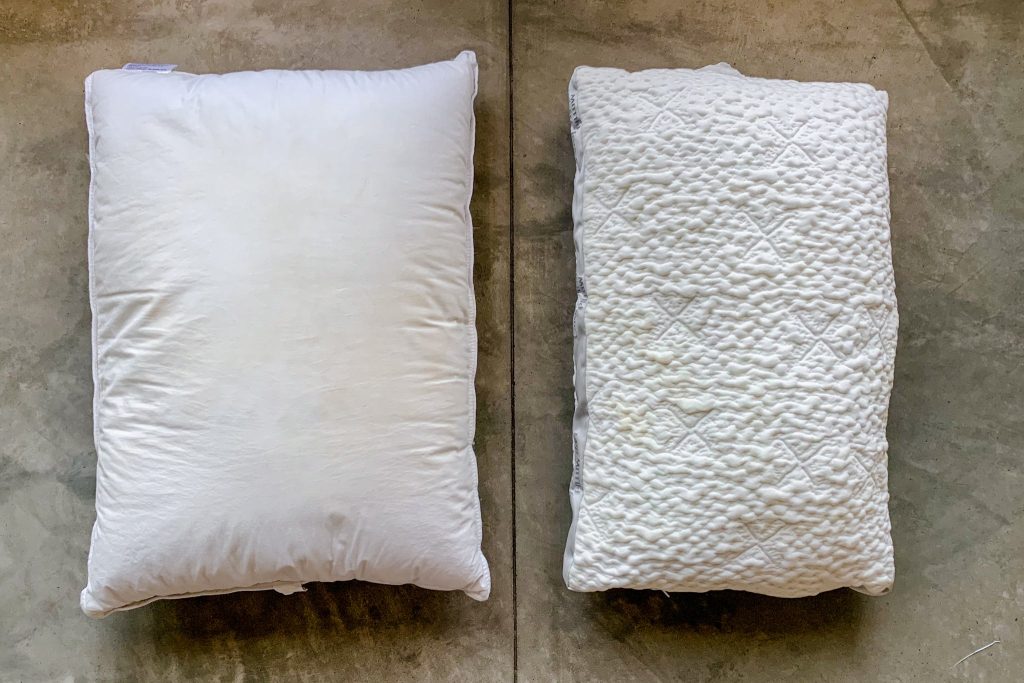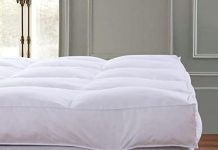Pillows are vital in ensuring a good night’s sleep, but have you ever wondered how often they should be washed?
In our quest to uncover the secret to a cleaner and healthier sleep environment, we explore the importance of maintaining clean pillows and provide valuable insights on the recommended frequency for washing them.
From the buildup of allergens and sweat to the appearance of unsightly stains, this article reveals why pillow hygiene should never be taken lightly.
So, get ready to discover the simple steps you can take to ensure a fresh and rejuvenating sleep every night.
Review contents
Signs that your pillow needs washing
Yellow stains
One of the most obvious signs that your pillow needs washing is the presence of yellow stains. These stains usually occur due to sweat, body oils, and saliva that accumulate over time. While it’s normal for pillows to develop discoloration over extended use, a noticeable yellow hue clearly indicates that it’s time for a thorough cleaning.
Visible dirt or grime
Another sign that your pillow needs washing is if you can visibly see dirt or grime on its surface. This can include dust, dirt particles, or other debris accumulated over time. Not only does this make your pillow look unsightly, but it can also harbor bacteria and allergens.
Foul odor
If your pillow emits a foul odor, it’s time to wash it well. Body sweat, oils, and saliva can create an unpleasant smell on your pillow. Not only can this be unpleasant to sleep on, but it can also impact the overall freshness and cleanliness of your bedding.
Allergy symptoms
If you wake up with allergy symptoms such as a runny nose, sneezing, or itchy eyes, it may be a sign that your pillow needs washing. Dust mites, pet dander, and other allergens can accumulate in your pillow over time, triggering allergic reactions. Regular washing can help alleviate these symptoms and create a healthier sleeping environment.
Clumps or lumps
When your pillow starts to develop clumps or lumps, it indicates that it needs a thorough cleaning. Clumps can form due to the accumulation of sweat, oils, and dead skin cells. These clumps affect the comfort of your pillow and can create an uneven sleeping surface that may result in neck or back pain.
Regular deep cleaning
Even if your pillow doesn’t exhibit any of the signs above, regular deep cleaning is still essential. Over time, pillows can accumulate dust, allergens, and bacteria that may not be visible to the naked eye. Washing your pillow regularly helps maintain its freshness and extends its lifespan.
Frequency of washing
Depends on pillow type
The frequency at which you should wash your pillows depends on your pillow type. Different materials and constructions may require different care routines to maintain quality and cleanliness.
Different recommendations for different pillows
Synthetic pillows, down and feather pillows, memory foam pillows, latex pillows, buckwheat pillows, specialty pillows – each of these pillow types has its own set of washing recommendations. It’s essential to familiarize yourself with the manufacturer’s specific care instructions to ensure that you clean your pillows correctly.
Synthetic pillows
Synthetic pillows, such as polyester or microfiber, are typically machine washable. Most synthetic pillows can be washed every 2 to 3 months, but checking the care label for specific instructions is crucial. You can keep your synthetic pillows fresh and clean using a gentle cycle and mild detergent.
Down and feather pillows
Down and feather pillows should be treated with a bit more care. Washing them too frequently can cause the feathers to clump and degrade the pillow’s overall quality. It’s generally recommended to wash down and feather pillows every 6 to 12 months. Follow the manufacturer’s instructions and use a delicate cycle with a mild detergent.
Memory foam pillows
Memory foam pillows are not machine washable due to their sensitive nature. Instead, spot cleaning is the preferred method for cleaning memory foam pillows. Use a mild detergent diluted in water and gently dab the stained area with a cloth. Ensure the pillow is completely dry before returning it to the bed.
Latex pillows
Latex pillows can be washed, but avoiding hot water or harsh detergents is essential, as they can damage the latex material. Hand washing with lukewarm water and mild soap is recommended for latex pillows. Rinse thoroughly and allow the pillow to air dry before use.
Buckwheat pillows
Buckwheat pillows require a bit more effort when it comes to washing. First, carefully remove the buckwheat hulls from the pillowcase. Next, spot-clean any stains on the pillowcase itself. To clean the buckwheat hulls, spread them flat and expose them to fresh air and sunlight for a few hours. Finally, refill the pillowcase with the cleaned buckwheat hulls and zip it back up.
Specialty pillows
Specialty pillows, such as those designed for specific health conditions or made from unique materials, may have their specific washing requirements. Always refer to the manufacturer’s instructions for proper care and cleaning methods.
Frequency for children’s pillows
Children’s pillows should be washed more frequently than adult pillows due to the higher likelihood of spills, accidents, and allergies. Washing children’s pillows once every 1 to 2 months is generally recommended or as needed.
Frequency for allergy sufferers
If you suffer from allergies, it’s advisable to wash your pillows more frequently to minimize the presence of allergens. Washing at least once every 1 to 2 months can help alleviate allergy symptoms and create a healthier sleeping environment.
How to clean different types of pillows
Synthetic pillows
To clean synthetic pillows, remove the pillowcase and place the pillow in the washing machine. Use a gentle cycle and a mild detergent. Adding an extra rinse cycle is also recommended to ensure all the detergent is thoroughly rinsed out. After washing, tumble-dry on low heat until completely dry.
Down and feather pillows
For down and feather pillows, it’s best to wash them in a front-loading washing machine to prevent damage. Use a delicate cycle and a mild detergent specifically designed for down and feather products. Drying the pillows thoroughly to prevent mildew is essential, so use a low heat setting and add a few tennis balls or dryer balls to help fluff the pillows as they dry.
Memory foam pillows
Memory foam pillows cannot be machine washed or dried, as the moisture can damage the foam. Instead, spot-clean any stains using a cloth dipped in mild detergent and water. Blot the stained area gently and allow it to air dry completely before putting the pillow back on the bed.
Latex pillows
To clean latex pillows, hand-wash them using a mild soap or detergent diluted in lukewarm water. Gently squeeze and knead the pillow to remove any dirt or stains. Rinse thoroughly with clean water and squeeze out any excess moisture. Allow the pillow to air dry thoroughly before use.
Buckwheat pillows
To clean a buckwheat pillow, remove the pillowcase and spot-clean any stains. Spread the buckwheat hulls on a flat surface and expose them to fresh air and sunlight for a few hours to eliminate odors. Once the hulls are dry, refill the pillowcase and zip it back up.
Specialty pillows
Since specialty pillows can vary significantly in terms of material and construction, it’s crucial to refer to the manufacturer’s instructions for cleaning guidelines. Follow your specialty pillow’s recommended cleaning method to ensure its longevity and effectiveness.
Preventing pillow contamination
Pillow protectors
Using pillow protectors is an excellent way to prevent pillow contamination. These thin, zippered covers are a barrier between your pillow and pillowcase, protecting it from sweat, oils, dust mites, and allergens. Pillow protectors are typically machine washable, so you can easily remove and clean them when needed.
Regular washing of pillowcases
Regularly washing your pillowcases is essential for maintaining the cleanliness of your pillows. Pillowcases should be washed at least once every 1 to 2 weeks, depending on personal preference and hygiene needs. Keeping your pillowcases clean and fresh minimizes the transfer of dirt, oils, and allergens to your pillows.
Avoiding eating in bed
Eating in bed can lead to crumbs, spills, and stains that can attract pests and bacteria to your pillows. It’s best to avoid eating in bed altogether to prevent any contamination that may occur.
Avoiding sleeping with makeup
Sleeping with makeup on can transfer oils, dirt, and bacteria to your pillow. This not only affects your pillow’s cleanliness but can also negatively affect your skin. Take the time to properly cleanse your face before bed to keep your skin and pillow free from unwanted particles.
Proper storage
When not used, pillows should be stored in a dry, clean area to prevent dust, dirt, and other particles from settling on them. Use pillow protectors or breathable storage bags to keep your pillows protected and fresh between uses.
Steps to wash pillows
Check care instructions
Before washing your pillows, always check the care instructions provided by the manufacturer. Different pillows may have specific requirements and limitations when it comes to cleaning. Following the care instructions ensures you don’t accidentally damage your pillows during washing.
Remove pillowcase
Start by removing the pillowcase from your pillow. This allows for a more thorough cleaning and prevents any residue from the pillowcase from transferring back onto the freshly washed pillow.
Pre-soak for stains
If your pillow has any visible stains, it’s beneficial to pre-soak them before tossing them in the washing machine. Follow the instructions on the stain remover and allow the pillow to soak for the recommended amount of time. This will help loosen and break down the stains, making them easier to remove during the washing cycle.
Choose the appropriate washing machine setting
Select the appropriate setting on your washing machine for your specific pillow type. Using a gentle cycle to prevent excessive agitation that could damage the pillows is generally recommended. Adjust the water temperature depending on the care instructions provided by the manufacturer.
Use gentle detergent
Use a mild or gentle detergent specifically formulated for delicate fabrics or pillows. Harsh detergents can be too abrasive and damage your pillows’ fibers or materials. Measure the detergent according to the manufacturer’s instructions and add it to the washing machine.
Balance the load
It’s essential to balance the load inside the washing machine to ensure that the pillows are evenly washed and rinsed. Adding a couple of lightweight towels or similar items can help balance the load and prevent your pillows from becoming lopsided during the washing cycle.
Agitate and spin
Start the washing cycle and allow the machine to agitate and spin the pillows. This helps to clean and rinse them thoroughly. If your washing machine has an extra rinse option, it’s advisable to select it to ensure that all traces of detergent are removed.
Dry thoroughly
After the washing cycle is complete, it’s crucial to dry your pillows thoroughly. Excess moisture can lead to mold, mildew, and an unpleasant smell. Depending on the pillow type, you can air-dry them or use a dryer. Refer to the specific drying instructions for your pillow type.
Fluff and reshape the pillow
Once the pillows are completely dry, fluff and reshape them to restore their original loft and shape. Gently knead and squeeze the pillows to distribute the filling evenly. This helps to maintain their support and comfort.
Use additional drying methods for certain types of pillows
Certain types of pillows, such as down and feather, benefit from additional drying methods to restore their fluffiness. Adding a few clean tennis balls or dryer balls to the dryer can help to break up any clumps and fluff the feathers. Check the care instructions for your specific pillow type to determine if this method is suitable.
Drying pillows
Air-drying
Air-drying is a safe and effective method for drying most pillow types. Simply lay the pillows flat on a clean surface in a well-ventilated area. Rotate the pillows occasionally to ensure even drying. Depending on the humidity level in your surroundings, it may take several hours or even a day for the pillows to dry completely.
Using a dryer
A dryer is a quick and convenient option for drying pillows, as long as the pillow type allows for machine drying. Place the pillows in the dryer on a low heat or delicate cycle. It’s essential to check the care instructions, as some pillow types may require a no-heat or air-only setting. Add a couple of clean tennis balls or dryer balls to help fluff the pillows as they dry.
Using tennis balls or dryer balls
Adding clean tennis balls or dryer balls to the dryer can help distribute the filling inside the pillows and restore their loft and shape. As the dryer tumbles, the balls agitate the pillows, preventing clumps and ensuring even drying. This is particularly beneficial for down and feather pillows.
Avoiding high heat
Regardless of the drying method chosen, it’s essential to avoid high heat, as it can damage the fibers or materials of your pillows. High heat can cause synthetic pillows to melt, foam pillows to warp, and feathers to lose their natural loft. Always refer to the care instructions for the recommended drying temperature.
Replacing pillows
Pillow lifespan
Pillows have a finite lifespan, and it’s essential to know when they must be replaced. On average, pillows should be replaced every 1 to 2 years, depending on their quality and usage. Over time, pillows accumulate dirt, dust mites, and allergens that cannot be effectively removed, affecting their comfort and hygiene.
Indications for replacement
There are several indications that it’s time to replace your pillows. These include lumps and clumps that don’t go away even after washing, a flattened or uneven shape, persistent odors, or frequent waking up with neck or back pain. If you notice any of these signs, it clearly indicates that your pillow has worn out its welcome.
General recommendation
Generally, it’s a good idea to reassess your pillows every 1 to 2 years and determine if they need to be replaced. Regular washing and proper maintenance can help extend the lifespan of your pillows, but eventually, they will need to be replaced for optimal comfort and support.
Considerations for allergy sufferers
For allergy sufferers, it’s essential to be more vigilant regarding pillow replacement. Since pillows can harbor allergens such as dust mites and pet dander, replacing them more frequently every 6 to 12 months may be necessary. Regularly washing allergen-proof pillow protectors can help prolong the lifespan of your pillows and minimize allergen exposure.
Considerations for neck pain sufferers
If you suffer from neck pain, replacing your pillows more frequently may be beneficial. Pillows that have lost shape or support can exacerbate neck pain or stiffness. Opting for a pillow designed for neck pain relief and replacing it as needed can help alleviate discomfort and improve sleep quality.
Other pillow maintenance tips
Regular fluffing
Regularly fluffing your pillows helps to maintain their loft and shape. Give your pillows a good shake and knead them to redistribute the filling. This prevents clumping and maintains their overall comfort and support.
Sun airing
From time to time, take advantage of sunny days to air out your pillows. Sunlight is a natural disinfectant and can help eliminate any lingering odors. Place your pillows in a sunny spot for a few hours to freshen them up.
Vacuuming
Vacuuming your pillows can help remove dust, dirt, and allergens that may have settled on the surface. Use the upholstery attachment on your vacuum and gently run it over the entire surface of the pillow. This is especially beneficial for pillows that cannot be machine-washed.
Avoiding direct sunlight exposure
While sun airing is beneficial, it’s essential to avoid prolonged exposure of pillows to direct sunlight. Continuous exposure to strong sunlight can cause the fabric or filling to deteriorate over time. Instead, choose a shady spot or limit your pillows’ time in direct sunlight.
Conclusion
Taking care of your pillows is crucial for maintaining a clean, fresh, and comfortable sleeping environment.
By recognizing the signs that your pillow needs washing and understanding the frequency and methods for cleaning different types of pillows, you can ensure that your pillows remain in optimal condition.
Regular cleaning, proper maintenance, and knowing when it’s time to replace your pillows will enhance your sleep’s longevity and quality. So, give your pillows the attention they deserve and enjoy a restful night’s sleep on clean and fresh bedding.




























